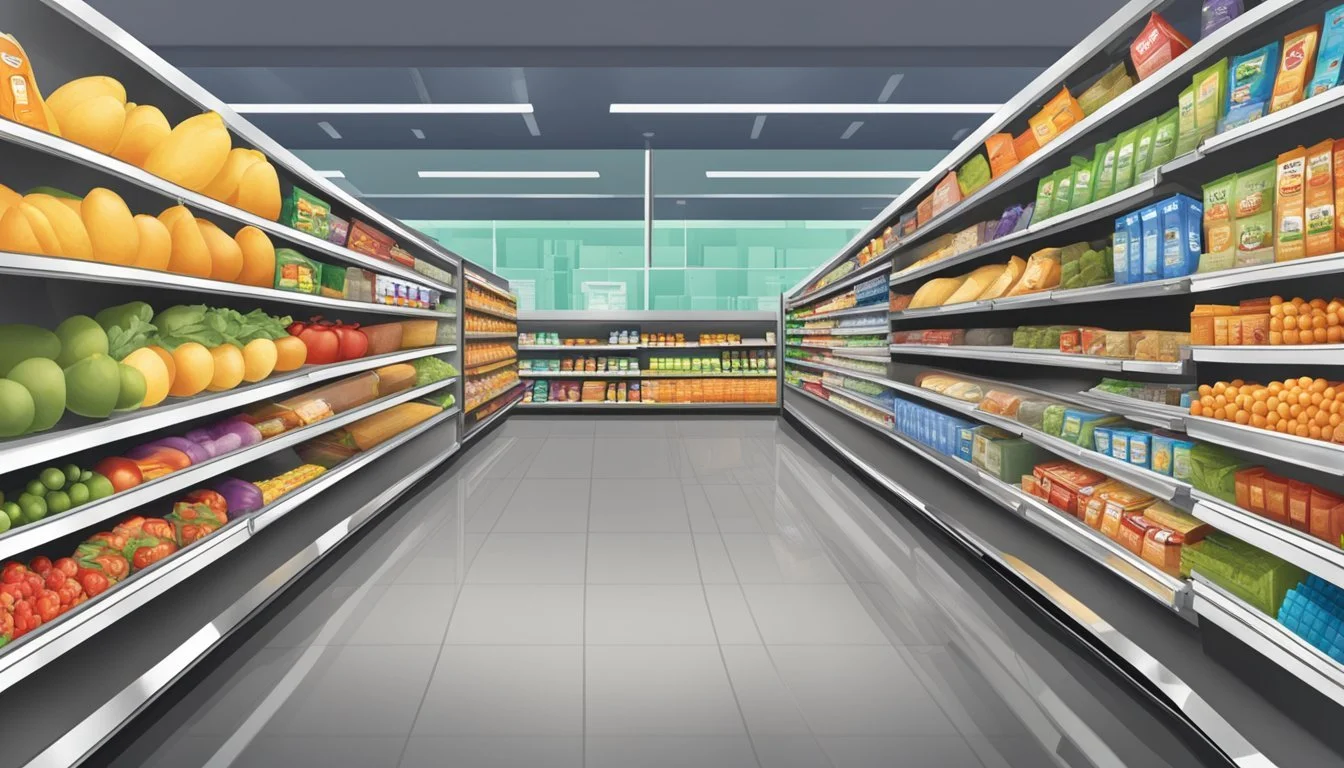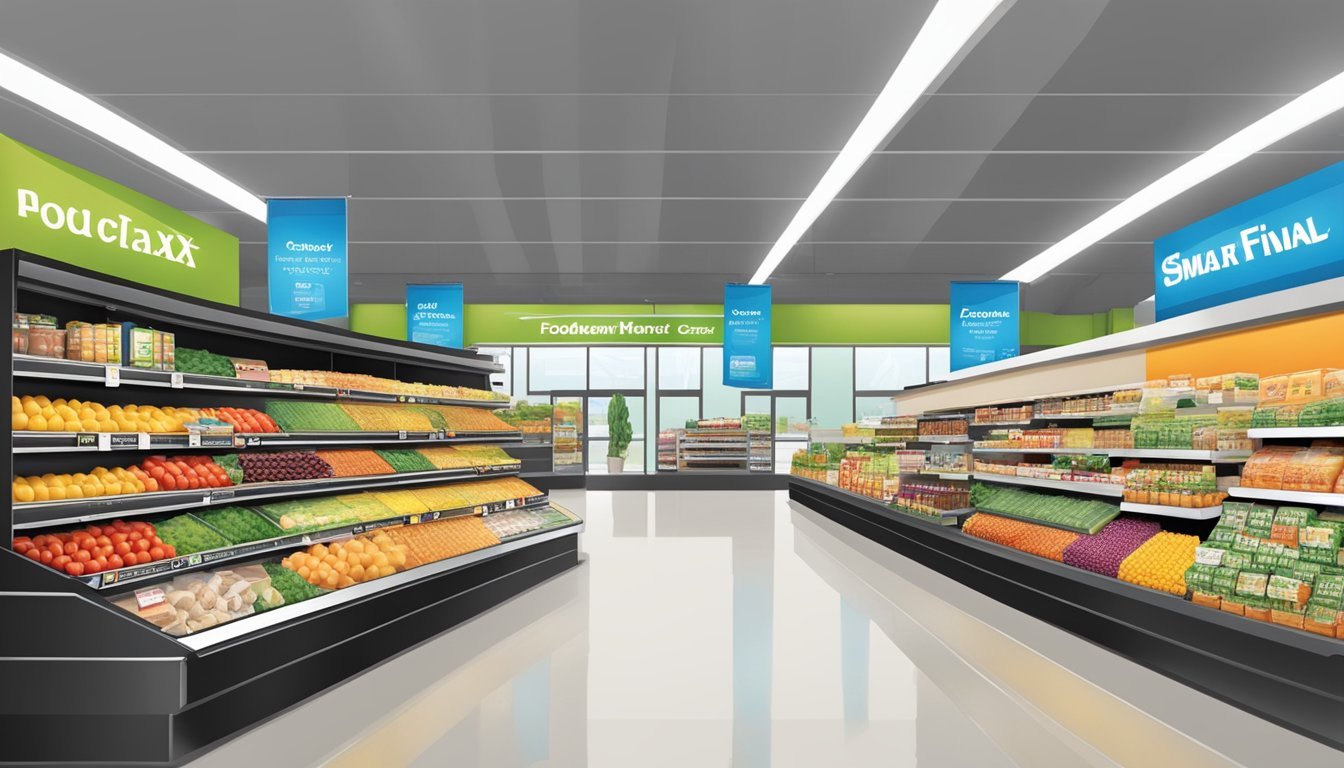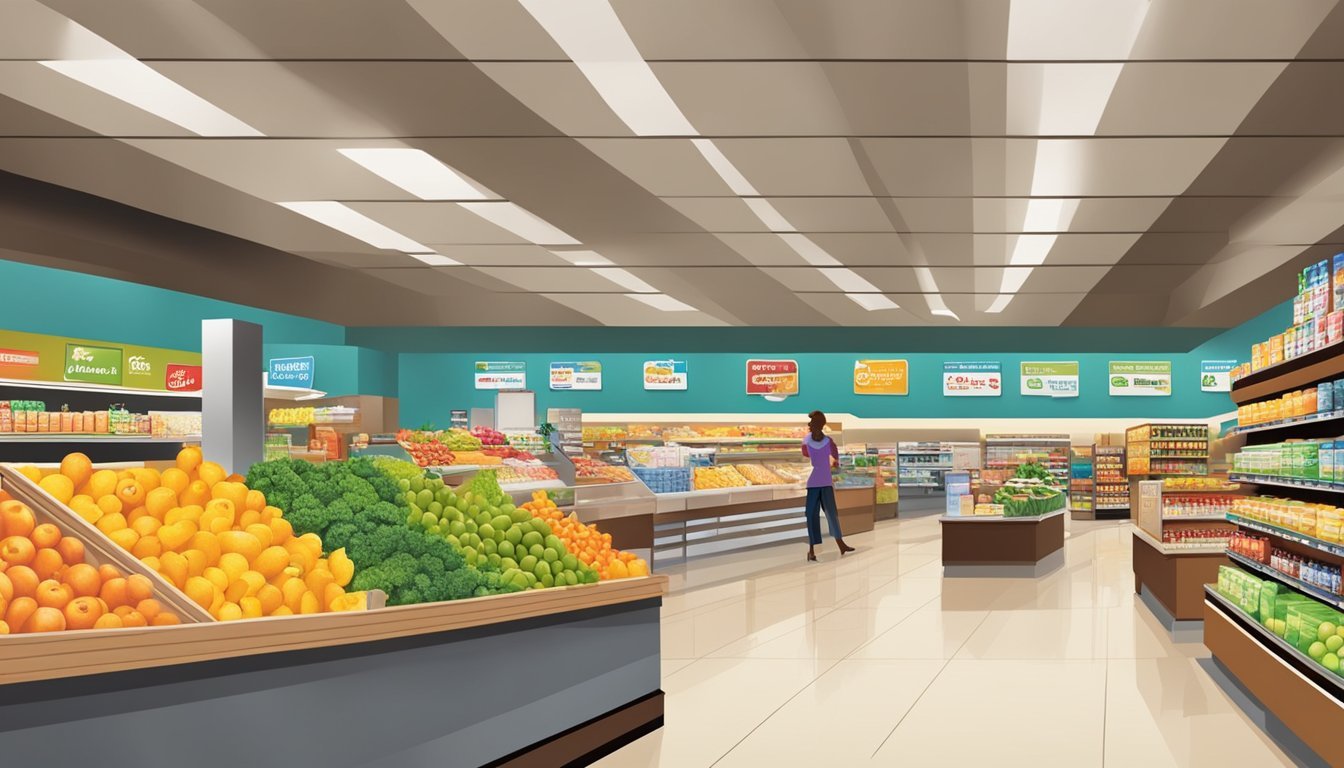FoodMaxx vs Smart & Final
A Comprehensive Comparison of Prices, Selection, and Quality
FoodMaxx and Smart & Final are popular grocery store chains known for offering competitive prices on a wide range of products. Both stores aim to provide value to budget-conscious shoppers, but they have some key differences in their approach and offerings.
FoodMaxx generally offers slightly lower prices overall, with prices averaging 21% below the all-store average compared to Smart & Final's 14% lower prices. This price difference can lead to significant savings for families who spend a substantial amount on groceries each week. However, price isn't the only factor to consider when choosing between these two stores.
Smart & Final positions itself as a warehouse-style store without membership fees, offering both bulk items and individual products. The store carries a mix of grocery items, fresh produce, and food service supplies. FoodMaxx, on the other hand, focuses on providing a no-frills shopping experience with a emphasis on low prices across its grocery selection.
Comparing FoodMaxx and Smart & Final
FoodMaxx and Smart & Final offer distinct shopping experiences tailored to different customer needs. Their store formats, product selections, and pricing strategies set them apart in the competitive grocery landscape.
Overview of Grocery Chains
FoodMaxx operates as a no-frills discount supermarket chain with about 53 stores in California and Nevada. It focuses on providing low prices by cutting operational costs and offering a streamlined shopping experience.
Smart & Final positions itself as a hybrid between a warehouse club and a traditional grocery store. With a wider geographic presence, Smart & Final caters to both household shoppers and small businesses.
Both chains emphasize value, but their approaches differ. FoodMaxx targets budget-conscious consumers with everyday low prices. Smart & Final offers bulk purchases and a mix of household and commercial products.
Store Formats and Experiences
FoodMaxx stores typically feature a simple layout with minimal decor. Shoppers often find products displayed in their original shipping boxes, reducing labor costs. This bare-bones approach allows FoodMaxx to maintain lower prices.
Smart & Final stores are generally larger and more polished. They offer a wider variety of products, including fresh produce, meats, and specialty items. The chain's warehouse-style format accommodates both individual and business customers.
Product selection varies between the two. FoodMaxx focuses on essential grocery items and popular brands. Smart & Final provides a broader range, including bulk quantities and food service supplies.
Pricing strategies differ as well. FoodMaxx aims for consistently low prices without sales or coupons. Smart & Final offers competitive pricing on bulk items and runs promotions to attract different customer segments.
Price Analysis
FoodMaxx and Smart & Final offer different pricing strategies and savings opportunities. A comparison of common item prices and available discounts reveals key differences between the two grocery chains.
Common Item Price Comparison
FoodMaxx tends to have lower prices on many everyday grocery items compared to Smart & Final. A price check of 19 common products showed FoodMaxx's total coming in at $42.61, while Smart & Final's total was $51.03 - a difference of $8.42.
Some specific examples:
Milk (gallon): $3.79 at Smart & Final
Dry goods like flour and sugar: Generally cheaper at FoodMaxx
FoodMaxx's pricing is typically 21% below the average of other grocery stores in the area. Smart & Final's prices are around 14% lower than average.
Discounts and Savings Opportunities
Both stores offer ways for shoppers to save beyond everyday low prices. FoodMaxx runs weekly sales and provides digital coupons through their app. They also have "loss leader" items priced very low to attract customers.
Smart & Final provides:
Club-size packaging for bulk savings
A rewards program with personalized deals
Digital coupons
Weekly ad specials
Smart & Final's larger pack sizes can lead to lower per-unit costs for some items. However, FoodMaxx's consistently lower base prices often result in greater overall savings for typical grocery trips.
Product and Service Offerings
FoodMaxx and Smart & Final offer distinct product selections and services to cater to different customer needs. Both stores aim to provide value, but their approaches and offerings vary in key areas.
Quality and Variety of Products
FoodMaxx focuses on providing a wide range of affordable grocery items. Their shelves stock numerous generic staples alongside name-brand products. Smart & Final, on the other hand, offers a mix of household and business-oriented products. They carry larger package sizes suitable for both families and small businesses.
FoodMaxx emphasizes competitive pricing on everyday items. Smart & Final stands out with its bulk offerings and restaurant-quality goods. Both stores stock fresh produce, meat, dairy, and pantry essentials.
FoodMaxx tends to have a more limited selection of specialty items. Smart & Final offers a broader range of gourmet and international products.
Exclusive and Organic Produce
Smart & Final has expanded its organic produce section in recent years. They offer a variety of organic fruits and vegetables, often at competitive prices. FoodMaxx's organic selection is typically smaller but still includes popular items like organic apples, carrots, and lettuce.
Both stores source local produce when possible. Smart & Final sometimes features exclusive partnerships with regional farms. FoodMaxx focuses on providing affordable conventional produce options.
The quality of produce can vary by location and season for both chains. Smart & Final generally receives positive feedback for its produce freshness.
Prepared Foods and Deli
Smart & Final offers a more extensive deli and prepared foods section. They provide hot foods, sandwiches, and rotisserie chickens in many locations. Their deli counters often feature a variety of meats and cheeses sliced to order.
FoodMaxx typically has a more limited deli selection. They focus on pre-packaged deli meats and cheeses. Some FoodMaxx stores offer basic prepared foods like rotisserie chickens, but the selection is usually smaller than Smart & Final's.
Smart & Final caters more to customers looking for quick meal solutions. FoodMaxx concentrates on providing affordable ingredients for home cooking.
Customer Experience
FoodMaxx and Smart & Final differ in their approaches to customer service and checkout efficiency. Both stores aim to provide value, but their focus areas impact the overall shopping experience.
Check-out Efficiency
FoodMaxx emphasizes a no-frills approach, often resulting in fewer open checkout lanes. This can lead to longer wait times during peak hours. The store encourages self-bagging to keep costs down.
Smart & Final typically offers more staffed lanes and self-checkout options. Their warehouse-style layout allows for faster processing of larger orders. The chain invests in technology to streamline the checkout process.
Both stores have loyalty programs that can speed up transactions for regular customers. FoodMaxx's program is more basic, while Smart & Final's offers additional perks and personalized deals.
Customer Service Ratings
FoodMaxx receives mixed reviews for customer service. Some shoppers appreciate the straightforward, budget-focused approach. Others report difficulties finding assistance on the floor.
Smart & Final tends to score higher in customer service ratings. They train staff to be more knowledgeable about product locations and bulk purchasing options. This can be particularly helpful for small business owners and families buying in large quantities.
Local store management plays a significant role in service quality for both chains. Customer feedback often highlights individual store experiences rather than company-wide trends.
Online reviews suggest Smart & Final has an edge in resolving customer complaints. Their more robust customer service infrastructure allows for quicker response times to issues.
Convenience Factors
FoodMaxx and Smart & Final offer different convenience features to cater to shoppers' needs. Both chains have made efforts to improve accessibility and provide modern grocery shopping options.
Grocery Delivery Options
FoodMaxx partners with Instacart to offer same-day delivery in many locations. Customers can order groceries online or through the Instacart app. Smart & Final provides delivery through Instacart as well, giving shoppers a similar experience. Both stores allow customers to schedule deliveries within one-hour windows.
Smart & Final also offers curbside pickup at select locations. Shoppers can order online and have their groceries brought out to their car. FoodMaxx does not currently provide curbside pickup services.
Store Locations and Accessibility
FoodMaxx operates about 53 stores across California and Nevada. Their locations tend to be concentrated in urban and suburban areas. Smart & Final has a larger footprint with over 250 stores in California, Nevada, and Arizona.
Smart & Final stores are typically open daily from 6 AM to 10 PM. FoodMaxx locations have slightly more limited hours, usually opening at 7 AM and closing at 9 PM or 10 PM depending on the day. Both chains offer wheelchair accessibility and handicap parking at their stores.
Smart & Final's wider geographic presence may provide better accessibility for some shoppers. However, FoodMaxx stores are often strategically located in densely populated areas to serve local communities.
Budgeting and Spending
Effective budgeting and smart shopping strategies can significantly reduce grocery expenses at FoodMaxx and Smart & Final. Careful planning and cost-conscious decisions help shoppers maximize savings while meeting their household needs.
Meal Planning and Budget Tips
Start by creating a weekly meal plan. This helps avoid impulse purchases and reduces food waste. Set a realistic budget, such as $250 per week for a family. Track spending to identify areas for potential savings.
Make a detailed shopping list based on planned meals. Check pantry inventory before shopping to prevent unnecessary purchases. Compare prices between FoodMaxx and Smart & Final for staple items like milk.
Consider buying in bulk for non-perishable goods and frequently used items. This can lead to substantial savings over time. Freeze excess perishables to extend their shelf life and reduce waste.
Cost-Effective Shopping Strategies
Compare unit prices rather than package prices to find the best deals. FoodMaxx and Smart & Final often have different pricing structures, so careful comparison is key.
Look for store-brand alternatives to name-brand products. These are often cheaper without sacrificing quality. Take advantage of sales and promotions, but only for items you actually need.
Use loyalty programs and digital coupons offered by both stores. These can provide additional savings on regular purchases. Consider shopping during off-peak hours when stores may offer better deals to attract customers.
Buy seasonal produce, which is typically cheaper and fresher. Frozen fruits and vegetables can be cost-effective alternatives when certain produce is out of season.
Societal and Economic Impact
FoodMaxx and Smart & Final play significant roles in their communities. Their operations affect local businesses, employment, and consumer spending patterns in meaningful ways.
Supporting Local Businesses
FoodMaxx and Smart & Final often partner with local suppliers and farmers. This collaboration helps sustain regional agriculture and food production. Both chains frequently stock locally-sourced produce and products, giving small producers valuable shelf space.
These partnerships create a ripple effect in the community. They support jobs beyond the grocery stores themselves. Local food artisans, bakeries, and specialty goods makers gain exposure through these larger retailers.
By featuring local items, the stores also cater to consumer preferences for fresh, regional foods. This strategy helps differentiate them from larger national chains.
Impact on Local Economy
FoodMaxx and Smart & Final serve as important employers in many areas. They provide jobs ranging from entry-level positions to management roles. This employment has a direct effect on local spending power and economic stability.
The stores' competitive pricing models influence broader market dynamics. Lower food costs can increase disposable income for area consumers. This extra money may then circulate through other local businesses.
Their presence can also attract other businesses to nearby locations. This clustering effect can revitalize commercial districts and increase foot traffic for surrounding shops.
However, these chains may also compete with smaller, independent grocers. This competition can pressure local stores to adapt or risk closure.
Market Position and Competition
FoodMaxx and Smart & Final compete in the crowded grocery store landscape, each carving out distinct niches. Both chains face stiff competition from larger national retailers and local specialty stores.
Competitive Analysis with Other Chains
FoodMaxx positions itself as a discount grocer, competing directly with chains like WinCo and Grocery Outlet. Its no-frills approach and focus on low prices appeal to budget-conscious shoppers. Smart & Final, on the other hand, targets both retail and business customers with its bulk offerings and restaurant-quality products.
Walmart and Target pose significant challenges to both chains with their extensive grocery sections and competitive pricing. Costco and Sam's Club compete with Smart & Final in the bulk goods market.
Regional chains like Safeway, Albertsons, and Lucky also vie for market share in areas where FoodMaxx and Smart & Final operate.
Consumer Loyalty and Brand Perception
FoodMaxx has built a reputation for rock-bottom prices, attracting price-sensitive consumers. Its loyal customer base appreciates the chain's focus on affordability over ambiance.
Smart & Final's brand is associated with quality bulk items and a wide selection of food service products. This unique positioning helps differentiate it from traditional grocers.
Both chains face challenges in competing with the perceived freshness and quality of stores like Whole Foods and Sprouts Farmers Market. They also contend with the convenience factor offered by neighborhood markets and specialty ethnic grocers.
Customer loyalty programs and targeted marketing efforts play crucial roles in retaining shoppers and building brand affinity for both FoodMaxx and Smart & Final.
Research and Insights
Comprehensive studies and consumer behavior analyses provide valuable insights into the comparison between FoodMaxx and Smart & Final. These findings shed light on pricing strategies, product quality, and customer preferences.
In-Depth Studies and Findings
Researchers from Consumerpedia conducted a thorough evaluation of both stores. Their survey revealed that FoodMaxx offered prices 21% lower than the average, while Smart & Final's prices were 14% below average. This difference could result in significant savings for families spending $250 weekly on groceries.
The study also examined product quality. Smart & Final received higher ratings for overall quality, particularly in fresh produce. FoodMaxx, however, excelled in providing budget-friendly options for bulk purchases.
A notable finding was the prevalence of undersized items at Smart & Final. Researchers advised consumers to check the price per pound carefully, as some products appeared cheaper but offered less quantity.
Consumer Behavior Analysis
The Consumerpedia podcast discussed shopping patterns at both stores. FoodMaxx attracted price-conscious shoppers who prioritized savings over brand loyalty. Smart & Final appealed to small business owners and large families seeking bulk purchases.
Consumer surveys indicated that FoodMaxx customers appreciated the no-frills shopping experience and lower prices. Smart & Final shoppers valued the wider selection of restaurant-quality items and the absence of membership fees typically associated with warehouse clubs.
Seattle-based customers reported preferring FoodMaxx for everyday essentials, while turning to Smart & Final for party supplies and bulk non-perishables. This behavior suggests that many consumers view the stores as complementary rather than direct competitors.







